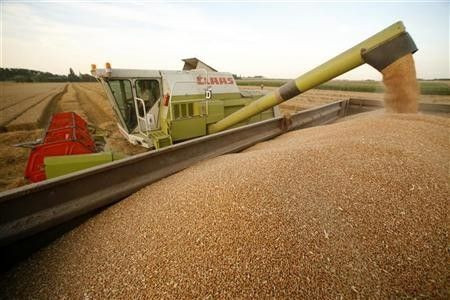Fertilizers: Gambling on the Global Grain Market

RBC Capital Markets said it has analyzed potential outcomes for global grain market conditions through 2015/2016 using Monte Carlo simulation analysis. The brokerage said Monte Carlo simulation suggests favorable odds for fertilizer investors.
Historically, fertilizer company valuations have been closely linked to fertilizer prices, which, in turn, are positively correlated to crop prices. Crop prices are a function of supply and demand and the stocks-to-use ratio is a convenient measure for evaluating the relationship between global grain supply and demand.
In general, a declining ratio suggests that market conditions are tightening with positive implications for crop prices and vice versa.
We have observed a general decline in the global stocks-to-use ratio over the last 13 years because growth in production has not kept pace with rising consumption. In order to evaluate the attractiveness of the fertilizer sector as an investable theme and, perhaps more importantly, assess the potential risk to sector valuations, we believe understanding where the global grain stocks-to-use ratio could potentially be heading is very important, said Fai Lee, an analyst at RBC Capital Markets.
However, it is difficult to arrive at a precise estimate for the ratio given that agricultural production is subject to many uncertainties such as weather conditions, soil fertility, moisture levels, farming practices, government policy, pestilence, plant genetics, etc.
In light of the inherent uncertainties associated with agricultural production, we developed a Monte Carlo simulation analysis to assess the potential risks and rewards associated with global grain market conditions by predicting potential outcomes for the global stocks-to-use ratio over the next 5 years, said Fai Lee.
In 76 of 100 trials, the 2015/2016 global stocks-to-use ratio was 19 percent or lower compared to the 2010/2011 global stocks-to-use ratio of 19.3 percent. In other words, Lee's analysis suggests that there is a reasonably high probability that global grain markets will tighten over the next five years, which has positive implications for crop prices and fertilizer sector valuations.
Lee said that in 50 of 100 trials, the global stocks-to-use ratio fell below zero. In reality, this is not possible because grain inventories cannot be negative. However, the negative-result trials highlight situations where global consumption would need to be reduced to offset insufficient global grain production.
In such situations, Lee could see a dramatic increase in grain prices, market intervention by governments, or both. While extremely high crop prices could be potentially positive for the fertilizer sector, these situations could also lead to political and/or economic instability, which may have an offsetting negative impact on fertilizer sector valuations.
Lee said investors, from a risk management perspective, should understand that favorable grain market conditions are not guaranteed as highlighted by the analysis. In 24 of 100 trials, the 2015/2016 global stocks-to-use ratio exceeded the current level and these scenarios would have potential negative implications for fertilizer sector valuations.
Our analysis suggests that the balance of probabilities with respect to global grain market conditions is favourable for fertilizer investors over the next five years. As such, we recommend fertilizer stocks be included as a core portfolio holding for long-term investors that understand the potential risks, said Lee.
© Copyright IBTimes 2024. All rights reserved.





















